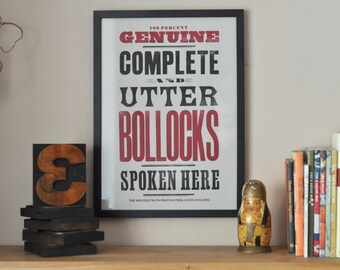Pulling the Press
Pulling the Press
After approximately three hours working in a “print shop,” I find it ever so slightly difficult to believe that people would want to go back to that time and do letterpress printing of ridiculously challenging works with great quality, just because of how long it took to do. But, here we are, in the age of the Internet, with Etsy stores popping up left and right and plenty of support for the old media.
Seems that old media dies hard.
On a less selfish note, it’s pleasing to see that people are making use of the old presses, which were otherwise sentenced to rot at the back of a museum until the dust lies thick upon them. It is certainly pleasing to lock the type in, and even more so to clamp the press down and release it, revealing an aesthetically pleasing design.

Poster designed, printed, and sold at this link
How did this Happen?
How could it be that the Youth of Today are turning to the Press of Yesterday?
Well, I think the idea isn’t too hard to wrap one’s head around. Emily Faithfull, who ran the Victorian Press, stated that the difference between a “good” and “bad” compositor was “the quality of mind and care applied to the work” (Faithfull, 39). Sure, there’s a certain nostalgia, and I enjoyed being “in touch” with the compositors of the past, but Letterpress allows for the youth of today to really get in touch with their past and make almost every single choice that they can possibly do, with the materials given. It makes it feel almost as personal as writing each one out personally.
How similar could it be?
Is the Past So Long Gone?
When it comes to the letterpress, it seems that a lot of the elements of the work ethic have stuck around. According to the 5th Color Article “The Resurgence of Letterpress Printing,” “designers love it for the hands-on experience of creating something in the physical world.” Faithfull would find this description lovely, as it means that her concept of the “mechanical” part of the workshop still gains all the love and affection that it used to have.
Unfortunately, there is a difference, which is how it gets funded. 5th Color also notes that “consumers love it for the feeling of old world charm and exclusivity it connotes.” The Letterpress Printer is little more than a fad at the current moment; something to point at on your wall and tell your friends “That was letterpress printed.” No longer does it have the attention it had back in Faithfull’s day, when an entire news article can be devoted completely to the efficiency and growth of a single print shop that people believed was destined to failure, with the newspaper itself printed from a different print shop. Mrs. Grundy wont be walking in to check on those Etsy printers to see if women are actually fit to work in them.
Nonetheless, the support for the printing shop, especially for these Letterpress Printers and Illuminators from the past is exciting, and shows that these old media are making a comeback. Maybe not all the way back to how it used to be, but certainly farther than most old media will ever be able to do.
Sources: Faithfull, Emily. “Women Compositors.” The English Woman’s Journal Volume VIII. February, 1862: 37-41. Print.
M. M. H. “A Ramble with Mrs. Grundy: A Visit to the Victorian Printing Press.” The English Woman’s Journal Volume V. August, 2060: 269-272. Print.
Sanderson, Paul. “Posts about Resurgence of Letterpress Printing on 5th Color.” 5th Color, Wordpress, 7 Nov. 2011, 5thcolor.wordpress.com/tag/resurgence-of-letterpress-printing/.
FIELDBOOKS
